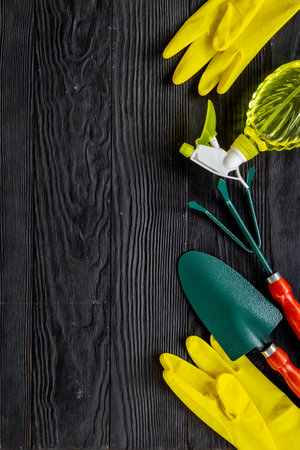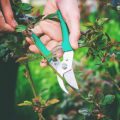1. Clean and Dry All Tools Thoroughly
Before you pack away your garden tools for the winter, its important to give them a good cleaning. Dirt, sap, and moisture left on your tools can lead to rust, corrosion, or even mold growth over time. Taking a little time now will help ensure your tools are in great shape when spring rolls around.
Step-by-Step Cleaning Guide
| Step | What to Do |
|---|---|
| 1. Remove Soil & Debris | Use a stiff brush or putty knife to scrape off any dirt or plant material stuck on shovels, hoes, and pruners. |
| 2. Wash with Soapy Water | Mix mild dish soap with warm water and scrub all metal surfaces. This helps eliminate sap and grime. |
| 3. Rinse & Dry Completely | Rinse with clean water and wipe dry with a towel. Let tools air-dry fully before storing. |
| 4. Remove Rust (if needed) | If you spot any rust, use steel wool or sandpaper to gently scrub it off. |
| 5. Apply Light Oil | Rub a light coat of motor oil or vegetable oil on metal parts using a cloth to prevent rust through the cold months. |
Helpful Tips
- Avoid using harsh chemicals—they can damage tool finishes and harm the soil next season.
- For wooden handles, consider lightly sanding them and applying linseed oil to prevent cracking or splitting during dry winter storage.
- Keep a bucket of sand mixed with oil in your garage—dip metal tools in it after cleaning for quick protection against rust.
Properly cleaning and drying your garden tools before storage is one of the easiest ways to extend their life and make spring gardening more enjoyable.
2. Sharpen Blades and Tighten Fasteners
Before putting your garden tools away for the winter, it’s a smart idea to give them a quick tune-up. Over time, dirt, rust, and regular use can dull blades and loosen screws. Taking care of these small issues now will make your spring gardening much easier.
Why Sharpening Matters
Dull blades not only make your work harder, but they can also damage plants by tearing instead of making clean cuts. This is especially true for pruners and shears. A sharp tool helps you get cleaner cuts with less effort, preserving the health of your plants.
Tools You Should Sharpen
| Tool | Reason to Sharpen |
|---|---|
| Pruners | Clean cuts reduce plant stress and disease |
| Shears | Makes trimming faster and more precise |
| Shovels | Easier digging in tough soil come spring |
| Hoes | Improves weeding efficiency |
Tighten Loose Parts
After a season of hard work, it’s common for screws, nuts, and bolts on your tools to come loose. Check all moving parts—especially on loppers, pruners, and rakes—and tighten anything that seems wobbly. This will help prevent breakage and keep your tools safe to use.
Quick Tip:
If a screw or bolt looks rusty or stripped, replace it now so you’re not stuck in the middle of a job later.
A little maintenance goes a long way. By sharpening blades and tightening fasteners before winter storage, you’ll extend the life of your tools and make next season’s gardening much smoother.
![]()
3. Store Tools in a Dry, Sheltered Space
Once your garden tools are clean and dry, it’s important to store them properly during the winter months. Moisture and poor storage conditions can lead to rust, wood rot, and damage that shortens the life of your tools. The best way to protect your investment is by keeping tools in a dry, sheltered space like a well-ventilated shed or garage.
Keep Tools Off the Ground
Storing tools directly on the floor exposes them to moisture and cold drafts. Instead, keep them elevated to prevent rust and corrosion. Use shelves, hooks, or tool racks to keep everything off the ground and organized.
Use Wall-Mounted Racks and Pegboards
Wall-mounted racks and pegboards are excellent for hanging tools like shovels, rakes, hoes, and pruners. This not only saves floor space but also makes it easy to see and grab what you need when spring arrives.
Tool Storage Options
| Storage Method | Best For | Benefits |
|---|---|---|
| Pegboards | Hand tools like trowels, pruners, gloves | Keeps tools visible and easy to access |
| Wall-mounted racks | Larger tools like rakes and shovels | Saves floor space and prevents tool damage |
| Storage bins or containers | Small parts or seasonal accessories | Protects from dust and moisture |
| Shelves or cabinets | Power tools or delicate items | Adds extra protection from temperature changes |
Avoid Moisture Buildup
Your storage area should be well-ventilated to avoid condensation, which can lead to rust. If your shed or garage tends to get damp, consider using moisture absorbers like silica gel packs or a small dehumidifier.
Quick Tip:
Label your storage areas so you know exactly where each tool goes. This helps prevent misplacement and keeps your workspace tidy all season long.
4. Protect Wooden Handles
Cold, dry winter air can be tough on wooden tool handles. Without proper care, the wood can crack, split, or develop splinters, making your tools uncomfortable or even unsafe to use next season. A little maintenance now can go a long way in keeping them in good shape.
Why Wooden Handles Need Extra Care
Wood is a natural material that reacts to changes in humidity and temperature. During winter, moisture loss from the wood can lead to shrinkage and cracking. Splinters may also form, making it harder to get a firm, safe grip on your tools when you need them again in spring.
Simple Steps to Preserve Wooden Handles
Follow these easy steps to protect your garden tools with wooden handles:
| Step | Description |
|---|---|
| 1. Clean the Handle | Use a stiff brush or cloth to remove dirt and debris from the handle. |
| 2. Sand Lightly | Use fine-grit sandpaper (like 120-150 grit) to smooth out rough spots or splinters. |
| 3. Apply Linseed Oil | Rub boiled linseed oil into the wood using a clean rag. Let it soak in for about 15 minutes, then wipe off any excess. |
| 4. Store Properly | Keep tools in a dry place like a shed or garage, off the ground and away from direct contact with cold surfaces. |
Choosing the Right Oil
Boiled linseed oil is commonly used because it dries faster than raw linseed oil and provides a durable finish. Make sure its labeled “boiled” before applying.
Tip:
Reapply linseed oil once or twice during the off-season if you live in an especially dry climate.
5. Winterize Power Tools and Equipment
As winter approaches, its important to properly store your gas-powered garden tools like lawnmowers, trimmers, and tillers. If left untreated, leftover fuel can degrade and form gum deposits that clog carburetors and fuel lines.
Drain the Fuel
Start by emptying the gas tanks of all your gasoline-powered equipment. Run the engine until it stops to ensure all fuel is burned off. This helps prevent residue buildup and keeps the internal parts clean.
Remove Batteries
For cordless tools, remove the batteries before storing them. Store the batteries separately in a cool, dry place—preferably indoors—to protect them from freezing temperatures, which can reduce battery life or cause permanent damage.
Clean Air Filters and Check Spark Plugs
Before storage, take a few minutes to clean or replace air filters. Dirty filters can make engines work harder when you start them up again in spring. Also, inspect spark plugs for wear or carbon buildup and replace if necessary.
Ideal Storage Conditions
If possible, store your power tools in a climate-controlled environment like a basement or heated garage. Extreme cold can crack plastic components and freeze lubricants, shortening the lifespan of your tools.
Quick Winterizing Checklist
| Task | Why It Matters |
|---|---|
| Drain fuel | Prevents gum buildup in carburetor |
| Remove batteries | Avoids freezing and prolongs battery life |
| Clean air filters | Keeps engine running smoothly next season |
| Check spark plugs | Ensures easy startup in spring |
| Store in climate-controlled area | Protects components from temperature damage |
Taking these simple steps now will help ensure your power tools are ready to go when gardening season returns—and save you time and money on repairs down the road.


